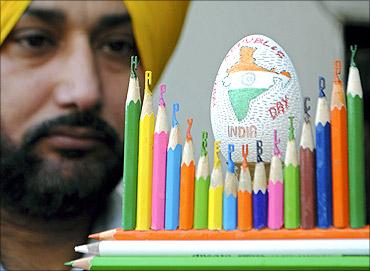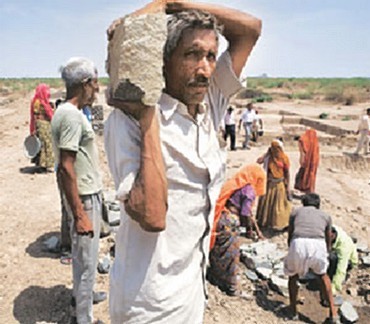Photographs: Reuters BS Reporter in Mumbai
India will need to retrain at least 285 million working Indians with no secondary education, said a study by McKinsey Global Institute.
Of these, 150 million have not even completed primary education.
Providing job-relevant vocational skills to these workers is a unique challenge that India faces, said the report.
Vocational education from the secondary school level should be pursued, and efforts should be made to retrain 285 million adult workers with just primary schooling or less, according to Anu Madgavkar, senior fellow, McKinsey Global Institute.
. . .
'India needs to retrain 285 million working individuals'
Photographs: Reuters
"This has been done in nations like South Korea, which did a good job of ramping up secondary and higher education with a focus on technical and vocational education. Similarly, South Africa is training teachers to impart basic skills to adult workers.
"Our numbers are larger, but targeting the young -- say 15-35-year olds -- would make it more manageable," she said.
The report released on Thursday explained that China would be replaced by India and the developing economies of South Asia and Africa as the new global source of new workers (middle-level workers with secondary education).
The image is for representation purpose only.
. . .
'India needs to retrain 285 million working individuals'
Photographs: Fabian Bimmer/Reuters
However, revealing a dichotomy in the system, it said that in India and younger developing countries, there could be as many as 58 million surplus low-skilled workers in 2020.
Due to low rates of high school enrolment and completion, it said that India could have 13 million fewer such workers; younger developing economies could have 31 million fewer of them.
Madgavkar said, "Early choices made in education, with a focus on universal secondary education, made China move ahead of India in the creation of medium-skill jobs.
. . .
'India needs to retrain 285 million working individuals'
Photographs: Olivia Harris/Reuters
"A huge thrust in China has been on rural education, helping generate non-farm jobs for people."
She added that in India, while there is a well-developed higher education system, there is little focus on upskilling the low-skill labour pool.
"We need to build and push secondary education in a big way to strengthen the base," said Madgavkar.
The report said India lags China in creation of higher value-added manufacturing and export-oriented jobs; 41 per cent of India's job creation in the past decade was in low-skill construction, compared to 16 per cent in China.
. . .
'India needs to retrain 285 million working individuals'
Photographs: Reuters
Though India rivals China in tertiary education attainment, the share of people with secondary school education is only about one-third the ratio in China, which could lead to a shortage of medium-skill workers for expanding labour-intensive industries.
According to the report, if current trends persist, in 2020 there could be one billion workers in the global labour pool without secondary education.
Hundreds of millions of working adults without job-relevant skills would need training; India alone has 340 million such workers, half of them with virtually no schooling.
. . .
'India needs to retrain 285 million working individuals'
Photographs: Reuters
To meet the enrolment targets at current levels of productivity in education, India will need to hire 1.2 million more secondary school teachers, almost doubling the current 1.5 million (as of 2009).
That will require expanding the teaching corps by nine per cent each year, compared to five per cent annually in the past.
The Indian labour force grew from approximately 260 million in 1980 to 470 million in 2010, and India created millions of non-farm jobs -- but not on the scale that China achieved.
. . .
'India needs to retrain 285 million working individuals'
From 2000 to 2010, India added 67 million non-farm jobs, just enough to keep pace with the growth of its labour force.
Just 12 per cent of India's non-farm job growth came from manufacturing, compared to 29 per cent in China.
India also has lagged behind China in raising the skills of its workforce.
While it has comparable numbers of workers with a tertiary education, the share of people with secondary education in India is less than half the ratio in China and many other developing economies.
. . .
'India needs to retrain 285 million working individuals'
Since it is difficult to set consistently defined standards of skills across the globe, Madgavkar said companies in sectors such as IT/software have been early pioneers in actively shaping college curricula and investing in training to raise skill levels standards to meet global requirements.
Taking a medium term outlook, given that China's population is ageing rapidly, she said India would be able to provide one of the largest pools of new workers globally.
To capture the opportunity, mid-level skills must be enhanced.
Explaining that a lot has to be done to improve the situation; Madgavkar concluded that private participation and vocational education could help India achieve the required number of medium-skill workers.










article